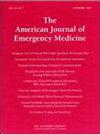Misdiagnosis of cellulitis in the emergency department and potential impact of clinical decision support interventions
IF 2.2
3区 医学
Q1 EMERGENCY MEDICINE
引用次数: 0
Abstract
Background
Cellulitis is misdiagnosed in 19 % to 34 % of emergency department (ED) cases resulting in excess healthcare spending and threatening patient safety. The objectives of this planned secondary analysis was to report the proportion of cellulitis misdiagnosis in the ED. Secondarily, we evaluated the potential impact of diagnostic adjuncts on misdiagnosis rates.
Methods
We prospectively enrolled ED patients presenting with acute lower extremity dermatologic complaints involving visible erythema (potential cellulitis). We abstracted the treating physician's diagnosis from the medical chart. Consensus diagnosis was determined by a group of six independent, multidisciplinary physicians. The treating ED physician's diagnosis was compared to the consensus panel diagnosis to identify errors. We evaluated the potential impact of two individual diagnostic adjuncts, skin surface temperature measurement and the ALT-70 score, plus a combination of both, on reducing cellulitis diagnostic errors
Results
The final sample included 201 patients. The diagnosis assigned by the treating physician and consensus panel was discordant in 50 of 201 cases (24.9 %). Among patients with an ED physician diagnosis of cellulitis, 35.6 % were overdiagnosed (48/135). In cases diagnosed as cellulitis, utilization of skin surface temperature, the two-level ALT-70 and the combination measure would have yielded an absolute reduction in cellulitis overdiagnosis by 8.9 %, 5.7 % and 13.0 % of cases respectively
Conclusion
Consistent with other reports, we observed a high rate of cellulitis overdiagnosis, highlighting the need for diagnostic support interventions. Proposed diagnostic adjuncts had an overall positive theoretical impact on overdiagnosis and should be evaluated in prospective interventional trials
急诊科蜂窝织炎的误诊及临床决策支持干预的潜在影响
背景:在急诊科(ED)的病例中,有19%到34%的蜂窝织炎被误诊,导致医疗支出过剩,并威胁到患者的安全。本计划的二级分析的目的是报告蜂窝织炎在急诊科误诊的比例。其次,我们评估了诊断辅助工具对误诊率的潜在影响。方法我们前瞻性地招募了伴有明显红斑(潜在蜂窝织炎)的急性下肢皮肤病主诉的ED患者。我们从病历中摘录了主治医生的诊断。共识诊断是由六名独立的多学科医生组成的小组确定的。将治疗急诊科医生的诊断与共识小组的诊断进行比较,以确定错误。我们评估了两种单独的诊断辅助手段,皮肤表面温度测量和ALT-70评分,以及两者的组合,对减少蜂窝织炎诊断错误的潜在影响。结果最终样本包括201例患者。201例病例中,50例(24.9%)治疗医师与共识小组的诊断不一致。在被ED医师诊断为蜂窝织炎的患者中,35.6%被过度诊断(48/135)。在被诊断为蜂窝织炎的病例中,利用皮肤表面温度,两级ALT-70和联合措施将使蜂窝织炎过度诊断率绝对降低8.9%,5.7%和13.0%的病例。结论与其他报告一致,我们观察到蜂窝织炎过度诊断率很高,强调了诊断支持干预的必要性。建议的诊断辅助手段对过度诊断总体上有积极的理论影响,应该在前瞻性介入试验中进行评估
本文章由计算机程序翻译,如有差异,请以英文原文为准。
求助全文
约1分钟内获得全文
求助全文
来源期刊
CiteScore
6.00
自引率
5.60%
发文量
730
审稿时长
42 days
期刊介绍:
A distinctive blend of practicality and scholarliness makes the American Journal of Emergency Medicine a key source for information on emergency medical care. Covering all activities concerned with emergency medicine, it is the journal to turn to for information to help increase the ability to understand, recognize and treat emergency conditions. Issues contain clinical articles, case reports, review articles, editorials, international notes, book reviews and more.

 求助内容:
求助内容: 应助结果提醒方式:
应助结果提醒方式:


